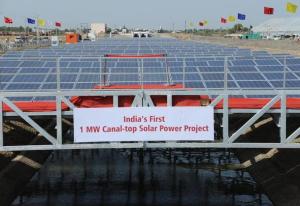Apparently the state of Gujarat (India) has inspired at least one other state, Punjab, to build (they hope) a network of photovoltaic (solar energy) plants over top of their canal system (from a Nov. 16, 2014 article by Mridul Chadha for cleantechnica.com),
…
India’s northern state of Punjab plans to set up 1,000 MW of solar PV projects to cover several kilometres of canals over the next three years. The state government has announced a target to cover 5,000 km of canals across the state. Through this program, the government hopes to generate 15% of the state’s total electricity demand.
Understandably, the construction of canal-top power plants is technically and structurally very different from rooftop or ground-based solar PV projects. The mounting structures for the solar PV modules cannot be heavy, as it could adversely impact the structural integrity of the canal itself. The structures should be easy to work with, as they are to be set up over a slope.
This is where the Punjab government has asked Lockheed Martin for help. The US-based company has entered into an agreement with the Punjab government to develop lightweight mounting structures for solar panels using nanotechnology.
Canal and rooftop solar power projects are the only viable options for Punjab as it is an agricultural state and land availability for large-scale ground-mounted projects remains an issue. As a result, the state government has a relatively lower (compared to other states) capacity addition target of 2 GW.
There’s more about the Punjab and current plans to increase its investment in solar photovoltaics in the article.
Here’s an image of a canal-top solar plant near Kadi (Gujarat),
 Image Credit: Hitesh vip | CC BY-SA 3.0
Image Credit: Hitesh vip | CC BY-SA 3.0
A Nov. 15, 2014 news item by Kamya Kandhar for efytimes.com provides a few more details about this Memorandum of Understanding (MOU),
Punjab government had announced its tie up with U.S. aerospace giant Lockheed Martin to expand the solar power generation and overcome power problems in the State. As per the agreement, the state will put in 1,000 MW solar power within the next three years. Lockheed Martin has agreed to provide plastic structures for solar panels on canals by using nano technology.
While commenting upon the agreement, a spokesperson said, “The company would also provide state-of-the-art technology to convert paddy straw into energy, solving the lingering problem of paddy straw burning in the state. The Punjab government and Lockheed Martin would ink a MoU in this regard [on Friday, Nov. 14, 2014].”
The decision was taken during a meeting between three-member team from Lockheed Martin, involving the CEO Phil Shaw, Chief Innovation Officer Tushar Shah and Regional Director Jagmohan Singh along with Punjab Non-Conventional Energy Minister Bikram Singh Majithia and other senior Punjab officials.
As for paddy straw and its conversion into energy, there’s this from a Nov. 14, 2014 news item on India West.com,
Shaw [CEO Phil Shaw] said Lockheed has come out with waste-to-energy conversion solutions with successful conversion of waste products to electricity, heat and fuel by using gasification processes. He said it was an environmentally friendly green recycling technology, which requires little space and the plants are fully automated.
Getting back to the nanotechnology, I was not able to track down any information about nanotechnology-enabled plastics and Lockheed Martin. But, there is a Dec. 11, 2013 interview with Travis Earles, Lockheed Martin Advanced materials and nanotechnology innovation executive and policy leader, written up by Kris Walker for Azonano. Note: this is a general interview and focuses largely on applications for carbon nanotubes and graphene.